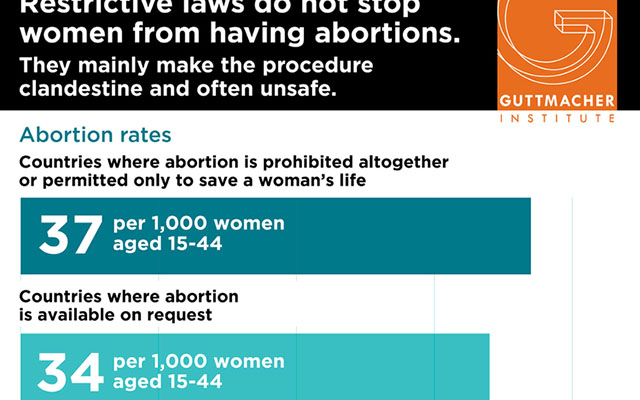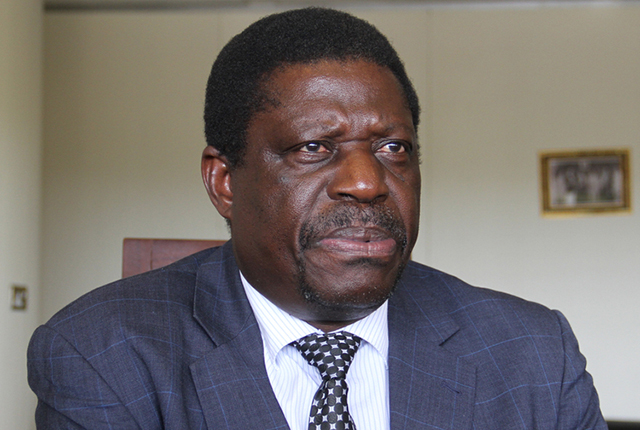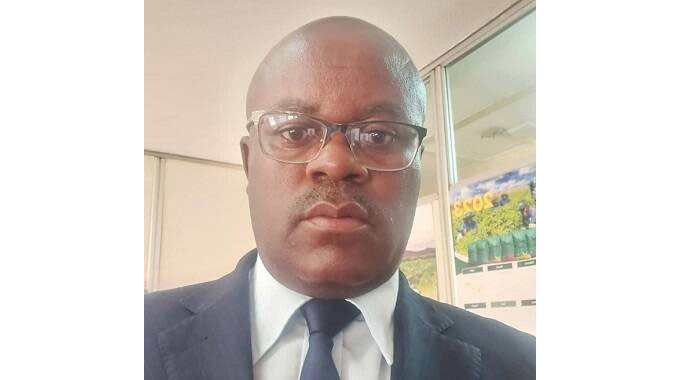Zim’s abortion dilemma: It’s the women who suffer

Roselyne Sachiti Features Editor
“My uterus was also damaged because of the pricking. The doctor had to remove it. I cried and begged him not to. He said I would die if he did not. The hysterectomy was performed when I was only 15.”
A small black pot “sits” on a paraffin stove in a poorly ventilated, crowded room at Mbare Flats, in Harare.
The smell of paraffin coupled with that of dried fish being boiled in the pot is overwhelming, and somehow acrid, yet inside the dim room; 31-year-old Pamela sits comfortably as she grates tomatoes.
She is the sole caregiver of her 80-year-old grandmother and ensures she is well fed daily. Pamela has stayed with her grandmother since her parents died when she was only five years old and they are best of friends — sometimes.
Her social life is not that exciting. All of Pamela’s friends are either married or have children, yet a mistake she made as a teenager has kept her from enjoying the same.
At 15, Pamela became pregnant and went for a backyard abortion which resulted in a hysterectomy as her uterus was badly damaged and developed a severe infection.
“When I was in Form 2, I became pregnant and my boyfriend Mike who was 10-years-older said he could not take care of me and the baby since he was married with two children.
“My classmate Sheila recommended that I visit a woman along Jo’burg lines also here in Mbare who was known for getting rid of unwanted pregnancies.
“That woman had helped Sheila’s sister Beulah to successfully abort. I asked the woman to help me abort. I wanted to finish school and move out of the dingy Mbare Flats. “I did not want to burden my grandmother who was struggling to take care of me and my two sisters,” said Pamela.
She did not tell her grandmother that she was pregnant as she feared that the old woman would take her to Mike who had refused responsibility. Young as she was, she had no knowledge of condoms as contraception or even other means of avoiding pregnancy.
“When I missed my period which was regular, I was scared. I cried. I screamed. I squeezed my tummy hoping the foetus would pop out. I wanted to commit suicide,” she explained. According to Sheila, the woman wanted money for the abortion service. She also asked her to bring cotton wool and a bucket.
“I asked my grandmother for money to buy textbooks but used it to pay for the backyard abortion,” she added. On the day of the abortion, the one and a half month pregnant Pamela and Sheila were knocking at the woman’s door as early as 5am.
The teenage girls did not want any prying eyes to see them since gossip moved fast in their neighbourhood.
“She told us to wait outside a bit since she was working on another patient who had come earlier. I started to have second thoughts as I could hear the girl screaming.
“I wondered what this woman was doing to her. I could hear the woman’s voice say ‘you better be strong, this is the result of having unprotected sex with married men at your age’.”
When the woman was done with her first “patient”, Pamela sheepishly walked in holding her small bucket. The time was now 9 am, the June winter cold, so were Pamela’s feet and hands.
“The woman was dark skinned, huge and her arms were flabby. She had a mean look, one that makes your heart pound fast. Her presence intimidated me.
“The room a small cabin was dark, darker than the one I lived in with my grandmother. A paraffin lamp provided light. There was a small mat, bucket of water, a pair of latex gloves, and a sharp stick.
“In another corner was a pile of bloody newspapers wrapping something. I concluded this was the foetus of the girl who had just left,” Pamela explained.
As Pamela was worrying about the contents of the bloody newspapers, the woman told her what she wanted her to do for the abortion to go on well.
“She told me to remove my panties and lay on my back. She slowly inserted the stick in my private parts aiming for my cervix. The first prick on my womb was excruciating. My immediate response was to put my legs together. She pulled them apart. I cried.
“Sheila who had remained outside was also afraid and knocked on the door asking her to stop. She did not want the responsibility of telling my grandmother what happened to me in the event I died.
“The woman told me to be strong since I had committed myself to this. After a while, I saw a gush of blood, some yellowish liquid and some clots coming down my legs. The woman told me the job had been done.
“She swore me to secrecy. ‘You do not know me, I do not know you’ were her exact words. I gave her money and left,” a teary Pamela reminisced tears flowing on her thin skin visibly damaged by overuse of skin lighteners.
She recalled how the journey back home was long and how her friend helped her. “Sheila and I walked slowly. I felt dizzy and almost fell. She held my hand,” she said. At home Pamela, no longer worried about being pregnant slept all the time hoping the excruciating pain would go.
“The woman gave me some traditional herbs to drink. I hid the small bottle under my grandmother’s bed. “The woman told me not to worry as the herbs would heal the uterus. I complied,” she said.
Pamela said she did not seek medical treatment to have her uterus lining scrapped by a doctor as she hoped the medicine from the woman who had conducted the illegal abortion would do the job.
She also did not know the implications of not scrapping the uterus lining to remove pregnancy tissue. She almost dug her own grave.
“A week after the backyard abortion, I started to feel dizzy as the bleeding did not stop. I started noticing puss coming out of my private parts. I felt sharp pains in the abdomen.
“I could not stand the pain and went to the clinic. They referred me to Harare Hospital where the gynaecologist told me that because of the uterus lining that was not scrapped, I had developed a serious infection which had become septic.
“My uterus was also damaged because of the pricking. The doctor had to remove it. I cried and begged him not to. He said I would die if he did not. The hysterectomy was performed when I was only 15. I have been living without my womb for 16 years,” she added.
Today, she is afraid of getting married yet she loves children. Her friend Sheila has four children from three different men.
Even if Pamela envies her, she is not mad at Sheila for referring her to the woman who helped her abort. She also cannot confront the woman who conducted the abortion as she died eight years ago.
“I don’t know what to tell any man who dates me. It is hard and embarrassing to tell them that I cannot have children because of the illegal abortion I had. I blame myself every day for the stupid decision I made. Sheila just supported me as a friend,” she said.
Pamela is among many women who in their teenage years sought illegal backyard abortions in Zimbabwe.
In Zimbabwe, abortion is illegal. The country’s Termination of Pregnancy Act only provides for abortion if the woman has been raped, a victim of incest, the pregnancy puts the mother at risk or the viability of the foetus was not certain.
Yet, despite the highly restrictive abortion laws in the country, teenage girls are still terminating pregnancies in backyards resulting in serious health complications and even death. In Zimbabwe, 16 percent of maternal deaths are due to unsafe abortions, half of which occur among adolescents.
The 2016 national adolescent fertility study found out that nine percent of adolescents between 10 and 19 years have fallen pregnant before, the majority of whom were girls from rural areas.
The report also said 28 percent of adolescents aged 15 to 19 years who had ever had sex used contraceptives during their first sexual encounter.
The main reasons cited by adolescent girls aged 15-19 for not using contraceptives during their first sexual encounter include the intention to become pregnant/wanted child (26 percent), about 16 percent did not know about contraceptive and 13 percent thought they would never get pregnant.
Sad is that in Zimbabwe’s health institutions, service providers use their discretion to restrict adolescents’ access to services and information to contraception and STI prevention.
Access to reproductive health services such as contraceptives is critical in avoiding unwanted pregnancies.
While society is absorbed in heated debates on whether or not to give teenagers condoms and contraception, to prevent pregnancy, it is fact that the same demographic is having unprotected sex, some of which has resulted in unplanned pregnancies leading to illegal abortion.
Cases like that of Pamela, make it more important for policy makers to be rational when making decisions that affect the health and well-being of teenagers and women.
Yes, society has its own views and fears on the morality of legalising abortion but there are also many merits especially on the health of women.
With one in every three girls in the developing world married by the age of 18 and one in seven before 15 years, it is also important to make policies that promote the dignity of women and girls. According to the Guttmacher Institute, the proportion of abortions that are performed under unsafe conditions globally is not currently known.
However, Guttmacher Institute said, the complications from unsafe abortions are common in developing regions, where the procedure is often highly restricted.
Estimates for 2012 indicate that 6,9 million women in these regions were treated for complications from unsafe abortions, corresponding to a rate of 6,9 women treated per 1 000 women aged 15–44.
Furthermore, most recent estimates suggest that some 40 percent of women who experience complications never receive treatment.
“Treating medical complications from unsafe abortion places a considerable financial burden on public health care systems and on women and families in developing regions.
“According to estimates for 2014, the annual cost of providing post abortion care in developing countries was US$232 million. If all those who needed treatment received it, the cost would be US$562 million.”
The Guttmacher Institute adds that almost all abortion-related deaths occur in developing countries, with the highest number occurring in Africa.
“Recent studies estimate that 8–18 percent of maternal deaths worldwide are due to unsafe abortion, and the number of abortion-related deaths in 2014 ranged from 22 500 to 44 000.”
As the debate on whether to legalise or not legalise abortion shapes up, people like Pamela keenly watch parliamentarians make decisions that could better or make worse the plight of women.
Feedback [email protected] or [email protected] Follow me on twitter @RoselyneSachiti










Comments